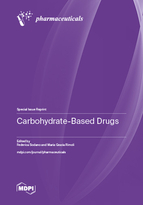Carbohydrate-Based Drugs
A special issue of Pharmaceuticals (ISSN 1424-8247). This special issue belongs to the section "Pharmaceutical Technology".
Deadline for manuscript submissions: closed (15 October 2022) | Viewed by 45394
Special Issue Editors
Interests: NO-donor; prodrug strategy; molecular hybrid design; drug design; drug delivery; drug targeting
Special Issues, Collections and Topics in MDPI journals
Interests: prodrug strategy; carbohydrate-based prodrugs; drug targeting; drug discovery
Special Issues, Collections and Topics in MDPI journals
Special Issue Information
Dear Colleagues,
Carbohydrates are one of the four major classes of biomolecules; they play important roles in various biological processes, including inflammation and immune response, angiogenesis and metastasis of cancer cells, viral and bacterial infections, and many other cell–cell communications. The tremendous effort made by glycoscientists in recent decades have allowed carbohydrate-based drugs to pave the way for an anonymous area of the therapeutic world.
Medicinal chemists use carbohydrates, particularly mono- and disaccharides, as valuable carriers or key substructures in order to improve the pharmaceutical phase, pharmacokinetics and pharmacodynamics of well-known drugs. Resorting to the prodrug strategy or multitarget drugs, the conjugation of a traditional drug to carbohydrates allows many limitations of the parent drug to be overcome, such as lack of site of action specificity, toxicity, chemical instability. Additionally, carbohydrate-based nanosystems have been shown to better deliver the starting drug or generate selective targeting towards specific body districts, as well as improve the cellular permeability and toxicological profile of the parent drug.
In this Special Issue, "Carbohydrate-Based Drugs", we aim to collect both original articles and up-to-date reviews that focus on the design, synthesis and biological evaluations of novel carbohydrate-based drugs, with a focus on carbohydrate-based prodrugs and nanosystems.
As Guest Editors, we encourage researchers working in this area to contribute their recent studies to this Special Issue of Pharmaceuticals.
Dr. Federica Sodano
Dr. Maria Grazia Rimoli
Guest Editors
Manuscript Submission Information
Manuscripts should be submitted online at www.mdpi.com by registering and logging in to this website. Once you are registered, click here to go to the submission form. Manuscripts can be submitted until the deadline. All submissions that pass pre-check are peer-reviewed. Accepted papers will be published continuously in the journal (as soon as accepted) and will be listed together on the special issue website. Research articles, review articles as well as short communications are invited. For planned papers, a title and short abstract (about 100 words) can be sent to the Editorial Office for announcement on this website.
Submitted manuscripts should not have been published previously, nor be under consideration for publication elsewhere (except conference proceedings papers). All manuscripts are thoroughly refereed through a single-blind peer-review process. A guide for authors and other relevant information for submission of manuscripts is available on the Instructions for Authors page. Pharmaceuticals is an international peer-reviewed open access monthly journal published by MDPI.
Please visit the Instructions for Authors page before submitting a manuscript. The Article Processing Charge (APC) for publication in this open access journal is 2900 CHF (Swiss Francs). Submitted papers should be well formatted and use good English. Authors may use MDPI's English editing service prior to publication or during author revisions.
Keywords
- carbohydrates
- carbohydrate hybrids
- nanosystems
- carbohydrate-based polymers
- prodrugs
- anti-inflammatory activity
- antimicrobial activity
- anticancer activity
- pharmacokinetics profile
- drug targeting
- toxicity
- biomedical applications








